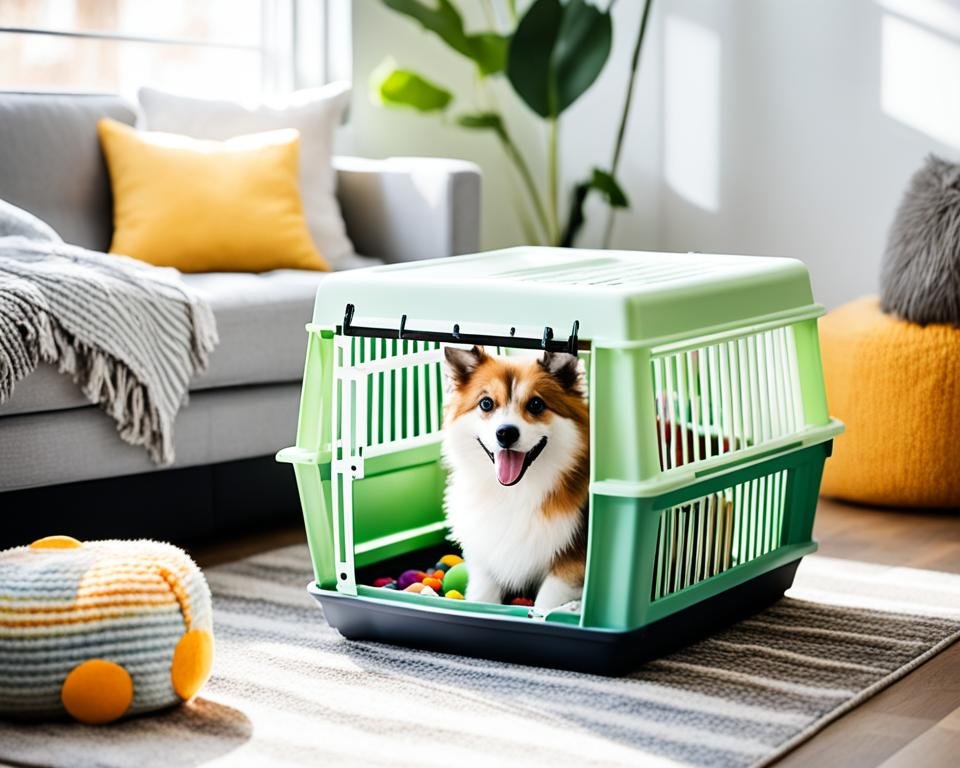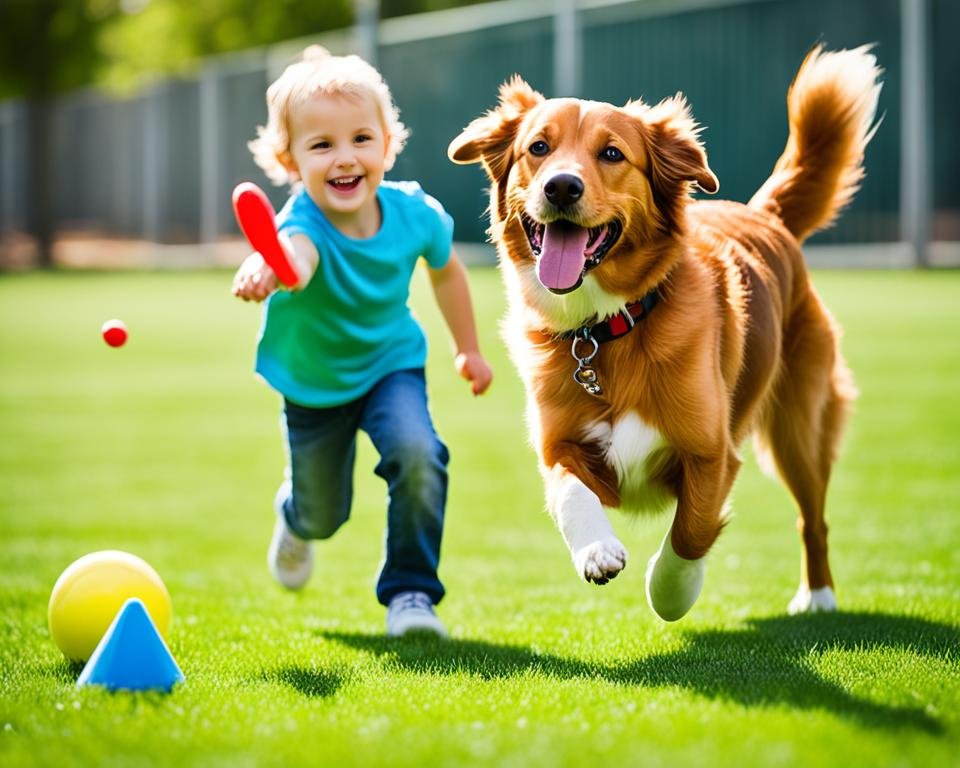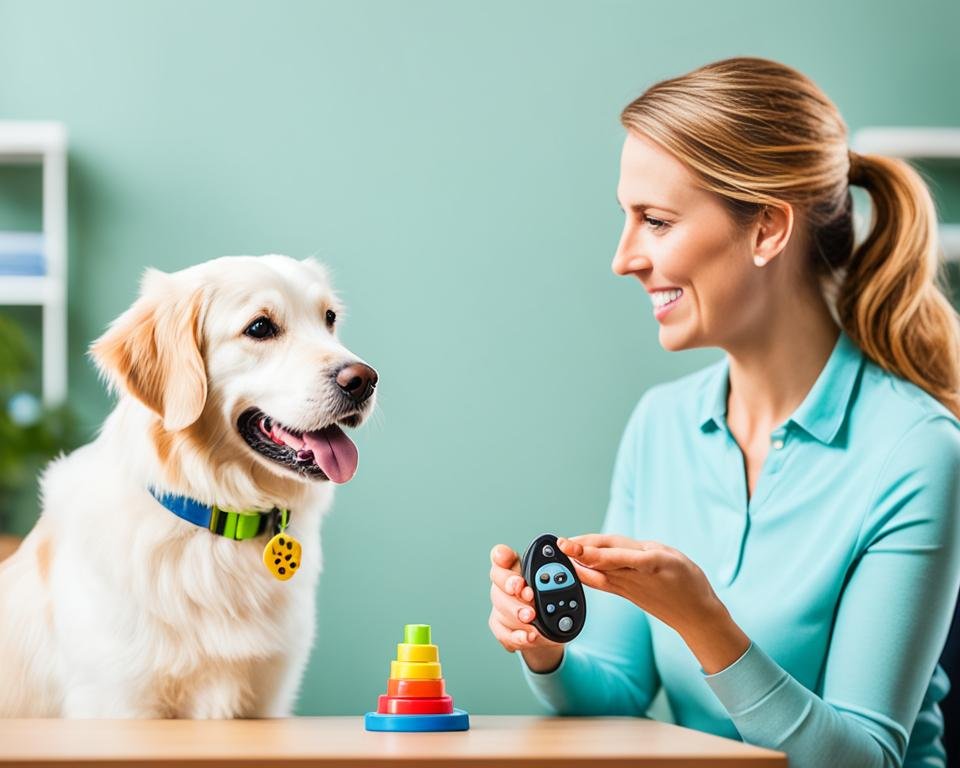Hello, pet owners! Training your furry companion is an essential aspect of pet ownership. Whether you have a mischievous puppy or an older pet who needs some behavior management, implementing effective training techniques is the key to fostering a well-behaved pet.
In this article, I will explore various training methods and tips that can help you establish a strong foundation for your pet’s training journey. From setting boundaries to utilizing positive reinforcement, we will cover a range of techniques to ensure a harmonious relationship between you and your pet.
Key Takeaways:
- Learning effective training techniques is crucial for a well-behaved pet.
- Setting early boundaries and house rules promotes consistent behavior management.
- Positive reinforcement training focuses on rewards rather than punishment.
- Choosing the right name and integrating play into training sessions are key factors in successful training.
- Consistency and patience play a vital role in pet behavior management.
The Importance of Early Boundary Setting
Setting boundaries and establishing house rules early on is crucial for shaping your pet’s behavior. By clearly defining what is allowed and what is not, you can prevent confusion and ensure consistent expectations. Understanding your pet’s boundaries and consistently reinforcing training can foster a well-behaved pet.
Establishing House Rules
Establishing house rules provides a framework for your pet to understand what behaviors are acceptable in your home. These rules can include guidelines for potty training, furniture access, and interaction with other family members and visitors. By consistently enforcing these rules, your pet will learn to respect and adhere to the expectations you have set.
Understanding Pet Boundaries
Every pet has their own boundaries and limits. It’s important to observe your pet’s reactions and body language to determine their comfort levels in different situations. Whether it’s respecting their personal space, understanding their tolerance for social interactions, or recognizing their fear triggers, understanding and respecting these boundaries will help build trust and prevent unwanted behavior.
Consistency with Household Expectations
Consistency is key when it comes to training your pet. It is essential to maintain consistent expectations and consequences for their behavior. This means everyone in your household should be on the same page and enforce the same rules. Inconsistencies in training can lead to confusion, making it more difficult for your pet to understand and adhere to the established boundaries.
Positive Reinforcement Training
Positive reinforcement training is an effective approach that focuses on rewarding desired behaviors. By using treats, praise, and affection, you can create a positive learning environment for your pet. This training method motivates your pet to repeat behaviors that result in positive outcomes, making learning more enjoyable and effective.
Reward-based training emphasizes the use of rewards, such as treats, to reinforce desired behaviors. When your pet performs a behavior correctly, you can provide immediate positive reinforcement by offering a treat. This helps your pet associate the behavior with a positive outcome, increasing the likelihood that they will repeat the behavior in the future.
In addition to treats, praise and affection are essential components of positive reinforcement training. Verbal praise, such as saying “good boy” or “good girl”, provides positive feedback and reinforces desired behaviors. Physical affection, like petting or gentle scratching, can also serve as a reward to motivate your pet.
By focusing on rewards instead of punishment, positive reinforcement training creates a harmonious and trusting bond between you and your pet. Your pet will be more motivated to learn and obey commands, as they associate training sessions with enjoyable experiences and positive outcomes.
Positive reinforcement training, including the use of treats, allows you to effectively communicate with your pet and establish clear expectations. This training method encourages your pet to make the right choices and helps shape their behavior in a positive way, leading to a well-behaved and happy pet.

Choosing the Right Name: A Key to Success
When it comes to training your pet, selecting the right name is a crucial first step. A well-chosen name not only reflects your pet’s individuality but also plays a significant role in their ability to respond to commands and develop good behavior.
The Impact of a Strong Consonant
One factor to consider when choosing a pet name is the use of a strong consonant. Names that start with a strong consonant sound, such as “Bella” or “Max,” can help your pet differentiate their name from other everyday sounds. This distinction can make it easier for them to recognize and respond to their name during training.
Adapting to a New Name
In some cases, you may be adopting a pet with an existing name. While it’s possible to adapt them to a new name, it’s essential to do so gradually and with patience. Start by using their current name alongside the new name during training sessions, gradually phasing out the old name as they become more familiar with the new one.
Choosing the right name for your pet is not a decision to be taken lightly. By selecting a name with a strong consonant and considering the process of adapting to a new name, you can set your pet up for success in their training journey.
Master Pet Obedience Training: Come When Called
Teaching your pet to come when called is a crucial aspect of obedience training. This command ensures the safety of your pet and allows for better control in various situations. Whether you are at the park, on a hike, or in your backyard, a reliable recall command is essential.
Recall training involves teaching your pet to respond promptly and reliably when you call their name or use a specific cue. By reinforcing positive experiences and using consistent training techniques, you can master the “come” command and strengthen the bond with your pet.
When starting recall training, it is important to find a quiet and distraction-free environment. Begin by calling your pet’s name in an excited and enticing tone. As soon as they start moving towards you, reward them with praise, a treat, or a combination of both. This positive reinforcement helps your pet associate the “come” command with a pleasant experience.
Consistency is key in recall training. Use the same cue word or phrase consistently, such as “come” or “here.” Practice the command in different situations and gradually increase the level of distractions. Over time, your pet will learn to come when called, even in challenging environments.
It is essential to avoid punishment or negative reinforcement when training the recall command. Maintaining a positive and enjoyable training experience will encourage your pet to respond willingly and eagerly.
Remember to keep training sessions short and frequent. Consistency and repetition are crucial for reinforcing the recall command and ensuring its effectiveness.
By investing time and effort into recall training, you can create a strong foundation for pet obedience. The ability to reliably call your pet will not only provide peace of mind but also enhance the overall safety and enjoyment of your pet’s life.
Training Your Pet for Success: Crate and House Training Basics
Creating a Positive Crate Experience
Creating a positive crate experience is crucial for successful crate training. Introduce your pet to the crate gradually, allowing them to explore it at their own pace. Place comfortable bedding and familiar toys inside to make it a cozy and inviting space. Associate the crate with positive rewards, such as treats and praise, to create a positive association. Remember to never use the crate as a form of punishment, as it should be a safe and positive place for your pet.

Integrating Crate Training with Housebreaking
Integrating crate training with housebreaking can accelerate the process of teaching your pet good bathroom habits. When your pet is in the crate, they are less likely to have accidents inside the house. Take your pet outside to their designated bathroom area immediately after being let out of the crate. This helps reinforce the association between going outside and using the bathroom. With consistent training, your pet will learn to hold their bladder and bowels until they are taken outside.
| Crate Training Tips | Housebreaking Tips |
|---|---|
|
|
By implementing these crate and house training basics, you can set your pet up for success in learning appropriate behavior and establishing good bathroom habits. Patience, consistency, and positive reinforcement will help you and your pet achieve a harmonious and well-trained household.
Effective Pet Training Techniques to Discourage Biting and Nipping
Understanding Puppy Behavior
Biting and nipping are common behaviors in puppies as they explore the world and learn social interactions. Understanding puppy behavior is crucial for addressing and redirecting these behaviors effectively. Puppies often bite as part of their play or teething process, but it’s important to teach them appropriate biting manners.
To discourage biting, it’s essential to recognize the underlying reasons behind your puppy’s behavior. Puppies often bite when they’re excited, seeking attention, or feeling anxious. By identifying these triggers, you can develop strategies to redirect their biting habits towards appropriate chew toys.
Redirecting Biting Habits
To effectively redirect your puppy’s biting habits, provide them with a variety of chew toys that are specifically designed for teething puppies. Offer these toys whenever you observe biting behavior, encouraging them to focus their chewing on appropriate items.
Consistency and positive reinforcement play a crucial role in redirecting biting habits. Whenever your puppy engages in appropriate chewing behavior, praise and reward them with treats or verbal praise. This positive reinforcement helps them understand which behaviors are desirable and reinforces their learning process.
It’s important to note that discouraging biting and nipping may take time and patience. Stay consistent in redirecting their behavior, and avoid using physical punishment, as this may lead to fear or aggression in your puppy. Instead, focus on providing alternative behaviors and reinforcing positive chewing habits.
Integrating Play and Training: A Recipe for Effective Pet Training
Combining play and training is an effective way to engage your pet and make training sessions enjoyable. By incorporating games into your training regimen, you can provide mental stimulation and reinforce desired behaviors.
Incorporating Games into Training Regimen
Integrating games into your pet’s training regimen adds an element of fun and excitement. By incorporating playtime into training sessions, you create a positive association with learning and motivate your pet to participate actively in the training process. These interactive activities not only stimulate your pet’s mind but also help them burn off excess energy, making them more receptive to learning and improving their overall behavior.
Using Fetch and Tug-of-War as Training Tools
Playing fetch and tug-of-war can be effective training tools to teach commands and improve obedience. These games engage your pet physically and mentally while reinforcing essential skills like retrieving and letting go of objects on command.
During fetch training, use clear commands such as “fetch,” “drop it,” or “bring it back” to encourage your pet to retrieve and return the desired object. Reward them with praise, treats, or a combination of both for successfully completing the task. Consistency is key in reinforcing this behavior and helping your pet associate the command with the desired action.
Tug-of-war can be incorporated into training to teach impulse control and practicing the “leave it” or “drop it” command. Ensure that your pet understands the rules of the game and stops tugging when you give the command to release. This helps them understand that they must relinquish any item they have in their mouth on command, which is crucial for their safety and preventing resource guarding behavior.

Transforming Challenges into Training Opportunities
During training, it is common to encounter challenges that may impede progress. However, these challenges should not be viewed as setbacks but as valuable learning opportunities. By approaching them with the right mindset and strategies, we can overcome training difficulties and turn them into catalysts for growth and progress.
Recognizing and identifying specific training challenges is the first step towards addressing them effectively. Whether it’s a stubborn behavior or difficulty grasping a command, understanding the root cause of the challenge is crucial. This allows us to tailor our training approach and focus on the areas that require additional attention.
Positive reinforcement is a powerful technique when tackling training challenges. By rewarding desired behaviors and providing encouragement, we can motivate our pets to overcome difficulties and learn new skills. This approach not only builds their confidence but also reinforces the bond between pet and owner, fostering a positive learning environment.
Patience plays a key role in transforming challenges into learning opportunities. Training takes time, and progress may not always be linear. It’s important to remain patient and persistent, understanding that each pet learns at their own pace. In moments of frustration, taking a step back, regrouping, and approaching the challenge with renewed determination can yield significant breakthroughs.
Consistency is another crucial factor in overcoming training difficulties. Maintaining a consistent training routine and approach helps solidify learning and reinforces desired behaviors. When faced with a challenge, consistent training allows us to provide clear expectations and guidance, increasing the likelihood of success.
By embracing challenges as learning opportunities, we can navigate the training journey with resilience and determination. With positive reinforcement, patience, and consistency, we can transform obstacles into stepping stones towards a well-behaved and obedient companion.
The Role of Consistency in Pet Behavior Management
Consistency plays a crucial role in effective pet behavior management. By staying consistent with commands and expectations, you can reinforce training and minimize confusion for your pet. Consistency provides a clear understanding of what is expected from your pet, helping them develop the desired behaviors and habits.
Staying Consistent with Commands
When training your pet, it is important to consistently use the same commands and cues. This helps your pet associate specific behaviors with the corresponding commands, reinforcing their understanding. For example, if you use “sit” as the command for your pet to sit down, consistently using this command will help them quickly grasp the desired behavior.
Consistent commands also prevent confusion. Pets thrive on predictability, and by using consistent commands and cues, you create a clear and structured training environment. This prevents miscommunication and helps your pet understand what is expected of them.
Benefits of Regular Practice
Regular practice is essential for maintaining and reinforcing your pet’s training. Just like any skill, consistent practice helps your pet retain what they have learned and continue to improve. By incorporating daily training sessions into your routine, you provide your pet with opportunities to practice commands and behaviors.
Regular practice also keeps your pet mentally stimulated and engaged. Dogs and cats are intelligent animals that enjoy mental challenges. Training sessions provide a chance for them to exercise their minds and stay mentally sharp. It is important to keep training sessions short and fun, ensuring that your pet remains focused and motivated.
Consistency and regular practice work hand in hand to shape and maintain your pet’s behavior. By staying consistent with commands and practicing regularly, you can establish a strong foundation for training and enjoy a well-behaved pet.
Socialization and Behavior Training for Pets
Socialization and behavior training are essential for well-rounded pets. By focusing on teaching comfort with being handled and developing positive interactions with other animals, you can create a harmonious environment that promotes your pet’s well-being.
Teaching Comfort with Being Handled
Teaching your pet to be comfortable with being handled is crucial for their overall happiness and welfare. This training ensures that they remain calm and cooperative during grooming sessions, vet visits, and other situations that involve physical contact. By gradually introducing handling exercises and using positive reinforcement techniques, such as treats and praise, you can help your pet develop a positive association with being touched.
Developing Positive Interactions with Other Animals
Positive interactions with other animals are vital for your pet’s social development and behavior. It helps prevent aggression, fear-based behaviors, and ensures that your pet can enjoy social situations. Introduce your pet to various species and sizes of animals gradually, always under controlled and safe conditions. Encourage positive behaviors, such as calmness and friendly interactions, with treats and praises. This training builds your pet’s confidence and helps them navigate social situations with ease.
By focusing on pet socialization and behavior training, including teaching comfort with handling and developing positive interactions with other animals, you provide your pet with essential skills for a happy and well-adjusted life. Invest time and effort into these training aspects, and you will reap the rewards of a well-socialized and well-behaved pet.
Conclusion
In conclusion, implementing effective training techniques is crucial for shaping a well-behaved pet. By utilizing positive reinforcement, such as rewards and praise, you can motivate your pet to learn and follow commands. Consistent training methods, coupled with clear boundaries and house rules, provide structure and ensure that your pet understands what is expected of them.
Addressing specific challenges during training, such as biting or nipping, can be achieved through redirecting their behavior towards appropriate chew toys and providing positive reinforcement. It is important to remember that training takes time, patience, and dedication. By practicing regularly and remaining consistent, you can establish a strong bond with your pet and enjoy their well-behaved demeanor for years to come.
By focusing on positive experiences, creating a positive crate environment, and incorporating play into training sessions, you can make the learning process enjoyable for both you and your pet. Transforming challenges into opportunities for growth and progress allows you to overcome obstacles and enhance your pet’s training journey. Socialization and behavior training, including comfort with handling and positive interactions with other animals, are also essential components of a well-rounded pet’s training regimen.
In summary, effective pet training techniques involve positive reinforcement, consistency, patience, and addressing challenges. By investing time and effort into your pet’s training, you can establish a strong bond and ensure their success in learning and following commands. With dedication and the right approach, you can enjoy a well-behaved pet that brings joy and harmony to your life.
FAQ
What is the importance of early boundary setting for my pet?
Establishing house rules and understanding your pet’s boundaries early on is crucial for shaping their behavior and ensuring consistency in training.
How does positive reinforcement training work?
Positive reinforcement training involves rewarding desired behaviors with treats, praise, or affection. This approach creates a positive learning environment and motivates your pet to repeat behaviors that result in positive outcomes.
How do I choose the right name for my pet?
Select a name with a strong consonant for your pet to differentiate it from other sounds. If you are adopting a pet with an existing name, you may need to adapt and gradually transition them to a new name.
How can I train my pet to come when called?
Teaching your pet the “come” command through obedience training and using positive reinforcement techniques can ensure that they respond promptly and reliably when called.
How can I effectively crate and house train my pet?
By gradually introducing your pet to the crate and associating it with positive rewards, you can create a positive crate experience. Additionally, integrating crate training with housebreaking helps establish good bathroom habits and accelerates the housebreaking process.
What can I do to discourage biting and nipping in my pet?
Understanding puppy behavior and redirecting their biting habits towards appropriate chew toys, while providing positive reinforcement, can help discourage biting and teach proper behavior.
How can I integrate play and training to effectively train my pet?
Incorporating games into your training regimen, such as fetch and tug-of-war, provides mental stimulation and reinforces desired behaviors, making training sessions enjoyable for your pet.
How can I turn training challenges into learning opportunities for my pet?
By identifying specific challenges and addressing them with positive reinforcement, patience, and consistency, you can transform obstacles into valuable learning experiences for your pet.
What role does consistency play in pet behavior management?
Staying consistent with commands and expectations reinforces training and minimizes confusion. Regular practice ensures that your pet retains learned skills and improves overall behavior.
How important is socialization and behavior training for pets?
Socialization and behavior training help your pet become well-rounded. Teaching them to be comfortable with being handled reduces fear and stress during grooming and veterinary visits. Positive interactions with other animals prevent aggression or fear-based behaviors.
Can you summarize effective training techniques for pets?
Incorporating early boundary setting, positive reinforcement training, consistent commands, and addressing specific challenges can help shape a well-behaved pet. Regular practice, socialization, and providing comfort with handling are also key.









